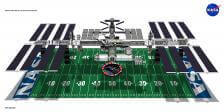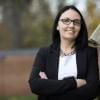What Will Astronaut Scott Kelly’s Year in Space Teach Us?
Astronaut Scott Kelly finally returns to solid ground after a NASA record-breaking 340 days in space. His epic journey—with the help of a comparison study of his twin brother!—will be a critical step toward our understanding of the toll space takes on the human body and ultimately toward sending humans on longer missions to Mars.
Sabrina Stierwalt, PhD
Listen
What Will Astronaut Scott Kelly’s Year in Space Teach Us?
Today Astronaut Scott Kelly returns to solid ground after 340 days in space – an impressive 125 days longer than the previous record for a NASA astronaut. This is Kelly’s fourth trip to space and brings his total time spent away from Earth to 520 days. Accompanying him on his so-called One-Year Mission is cosmonaut Mikhail Kornienko who has been collaborating with Kelly on their research conducted throughout the trip. You can check out the countdown clock to their expected landing near Kazakhstan, as well as a live video feed of their return, on NASA’s Click here for more information.
So what have they been doing for all this time?
Preparation for a Mission to Mars
For the past 11 months, Kelly has spent his time on board the International Space Station tracking his emotional and physical health. A mission to Mars is expected to take ~30 months so the One-Year Mission is a crucial step toward understanding the toll this will take on human travelers, both mentally and physically.
My favorite aspect of the experiment, the one that makes it so unique and provides the most potential for giving us important answers, is that the same tests have been taken by retired NASA Astronaut Mark Kelly, Scott Kelly’s twin brother!
As many scientists—and those who may remember high school biology—know, it can be very hard to find a good control sample for your experiment. So every time Scott Kelly took a biological sample in space (think saliva, blood, urine, and poop), his twin brother Mark took the same sample, down here on Earth.
In fact, the biological tests began a full year before the astronaut and cosmonaut even left to start their trip. With these samples and tests serving as baselines, Kelly and Kornienko have been testing themselves throughout their year in space to assess the mental and physical toll on the human body due to the combination of microgravity, increased radiation, and isolation in space. The lack of the full tug of gravity we feel here on Earth has been known to affect bone density, and muscle strength, which both weaken due to lack of use. Since the heart no longer has to pump as hard to push blood to the legs, it also can weaken and even shrink. Fluids, no longer being pumped to the legs, can also then gather in the face, a swelling that can adversely affect vision. Even our gut microbiome can suffer!
And those are just the physical effects of being in space …
Additionally, Astronauts have also experienced a large impact on mood, stress levels, and cognitive function. Clearly a concerted effort will need to be made in preparation for any future trips to Mars to combat the psychological pressures of such a much longer mission which will place travelers in an even more confined space.
He has shared pictures of gorgeous sunsets, impressive auroras, the night city lights of India, and even Hurricane Patricia and the Super Bowl.
Kelly, who turned 51 while onboard the ISS, has also sent us breathtaking pictures of our planet from above, many of them via Twitter to his > 915,000 followers. He has stated that watching the pollution that covers large parts of our planet has made him more of an environmentalist. He has shared pictures of gorgeous sunsets, impressive auroras, the night city lights of India, and even Hurricane Patricia and the Super Bowl.
A Short (But Harrowing) Return Trip

Although the One-Year Mission comes to an end today, the exploration of the full extent of the knowledge we will gain from the efforts of Kelly, his brother, and Kornienko will have just begun. I definitely look forward to learning more about this important step toward putting humans on Mars!
Until next time, this is Sabrina Stierwalt with Ask Science’s Quick and Dirty Tips for helping you make sense of science. You can become a fan of Ask Science on Facebook or follow me on Twitter, where I’m @QDTeinstein. If you have a question that you’d like to see on a future episode, send me an email at everydayeinstein@quickanddirtytips.comcreate new email.
Images courtesy of nasa.gov

